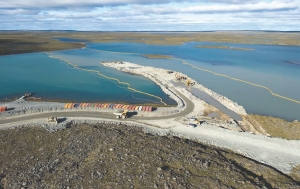VANCOUVER — Ten years ago, when Nunavut was created, the area was witnessing the end of a productive mining era. The zinc mines at Polaris and Nanisivik and the Lupin gold mine had reached the ends of their lives and exploration activity in the territory stood at a modest $37 million annually.
How times have changed. Over the past decade, exploration activity has grown more rapidly in Nunavut than anywhere else in the country; annual exploration spending now averages $300 million. And in that time, a healthy number of projects have moved from exploration to development. Agnico-Eagle Mines’ (AEM-T, AEM-N) Meadowbank mine is almost complete and is expected to produce its first gold in early 2010. And Paris-listed Areva’s Kiggavik uranium project, Baffinland Iron Mines’ (BIM-T, BIMGF-O) Mary River iron ore project, and Newmont Mining’s (NMC-T, NEM-N) Hope Bay gold project are at feasibility stage and poised to start construction.
So what happened to create such interest in a cold, expensive place to work? Two speakers at a recent Nunavut symposium in Vancouver outlined three concrete reasons. The territory’s deputy premier Peter Taptuna, who is also its mines minister, took the stage first, followed by Dave Coffin, co-founder of newsletter Hard Rock Analyst.
Both told the same story: the Nunavut government, recognizing that settled land claims and mineral potential gave it a golden opportunity, worked hard and fast to create regulations around exploration and development and to deepen the geological understanding of their land. And the effort worked.
“They implemented a complete regulatory framework in ten years,” Coffin said. “That is an achievement that should not be dismissed — the reality that the territory has been able to achieve as much as it has in ten years is impressive.”
Nunavut’s mineral regulations were developed from the Nunavut Land Claims Agreement (NLCA), which gave Inuit title to 356,000 sq. km of land or 18% of the territory. Of that, Inuit hold surface title on 16% of the territory. In a further 2% of the territory, Inuit hold surface and sub-surface rights. In the NLCA negotiations, the Inuit chose their sub-surface rights areas based on mineral potential.
Surface rights are held by one of the three Regional Inuit Associations, while Inuit subsurface rights are held and administered by Nunavut Tunngavik Inc. (NTI). NTI issues rights to explore and mine its lands through its own mineral tenure regime while the Crown administers its 98% of Nunavut’s subsurface rights through Indian and Northern Affairs Canada, which bases its decisions on the Northwest Territories and Nunavut Mining Regulations.
While the arrangement sounds complicated, in fact, Nunavut offers arguably the most straightforward land tenure systems in the country. And since ownership is settled, there are no concerns about land claims arising down the road. Furthermore, in mid-2008, the interested parties developed an amendment to the NLCA to avoid duplication in the environmental assessment process for Nunavut projects — unlike others parts of the country, wherein projects have to pass provincial and federal environmental processes, Nunavut offers a single review process.
So the regulations are straightforward and land ownership is clear. None of that would matter, though, if the territory did not also offer serious exploration potential.
Nunavut is large, underexplored and home to prospective rocks. A previous surge of interest in the 1970s led to several significant discoveries but when the oil and gas companies driving that surge retracted from mineral exploration in the 1980s, the area was left alone.
But it wasn’t left without potential. Nunavut offers 2 million sq. km of highly prospective geology. Much of the territory is underlain by Archean-age rocks, offering base and precious metal potential; the Thelon basin is a copy of Saskatchewan’s uranium-rich Athabasca basin; and other areas hold potential for iron ore. As Coffin put it: “Nunavut offers one of the best opportunities in the world as an emerging mineral district.”
A lack of geological information, however, had left that potential largely unnoticed and difficult to assess. In 1999, the public database of geological information for Nunavut was totally inadequate, containing far less information than could be found in databases for other parts of the country. The Nunavut government recognized that gap and worked to rectify it, within a few years founding the Canada- Nunavut Geosciences Office — mandated to create an understanding of Nunavut’s geology comparable to other Canadian jurisdictions.
The office has to date gathered a great deal of data and continues to work on numerous projects. One that warrants mention is the Geomapping for Energy and Minerals Initiative. Over the next five years, the federal government is investing $75 million into new geoscience mapping north of 60,including several major mapping projects across Nunavut.
Now, with a stable government, a regulatory framework, and a constantly growing database of mineral information, exploration in Nunavut is on the rise. And companies are staking swaths of land in the hopes of making big discoveries.
“Would you invest in a company that held the exploration rights to the entire Kirkland Lake or Timmins greenstone belt?” Taptuna asked. And his question makes sense — several companies, such as Commander Resources (CMD-V, CMDRF-O) and CBR Gold (CBG-V, CBGFF-O), have indeed staked entire greenstone belts.
Gold is by no means the only prospect. Coffin believes Nunavut has good potential for new diamond and uranium discoveries.
“The evolution of the diamond play in Canada is reaching a new threshold,” Coffin said. “In Nunavut, there are a number of projects with significant potential that could move to the diamond mining stage. And I think that could reignite interest in the balance of the play in Canada.
“And the uranium in Nunavut is old — there was a phase of exploration in the 1970s — and new in that a lot of ground has been picked up lately. There is strong reason to believe that a uranium industry is about to blossom in the territory.”


Be the first to comment on "Nunavut Rewarded With Exploration Resurgence"